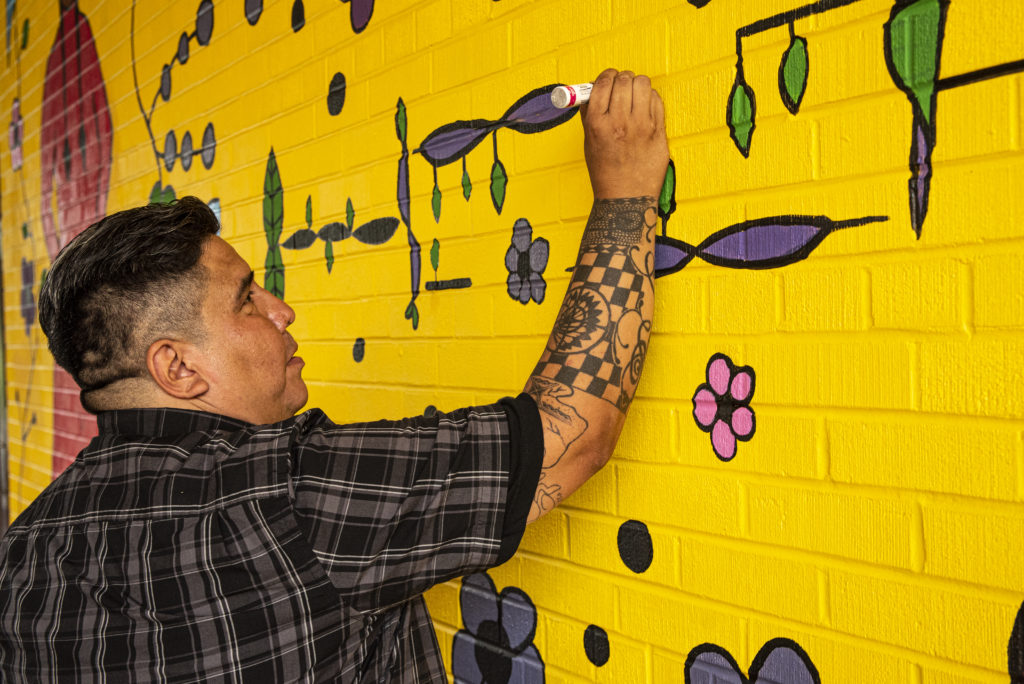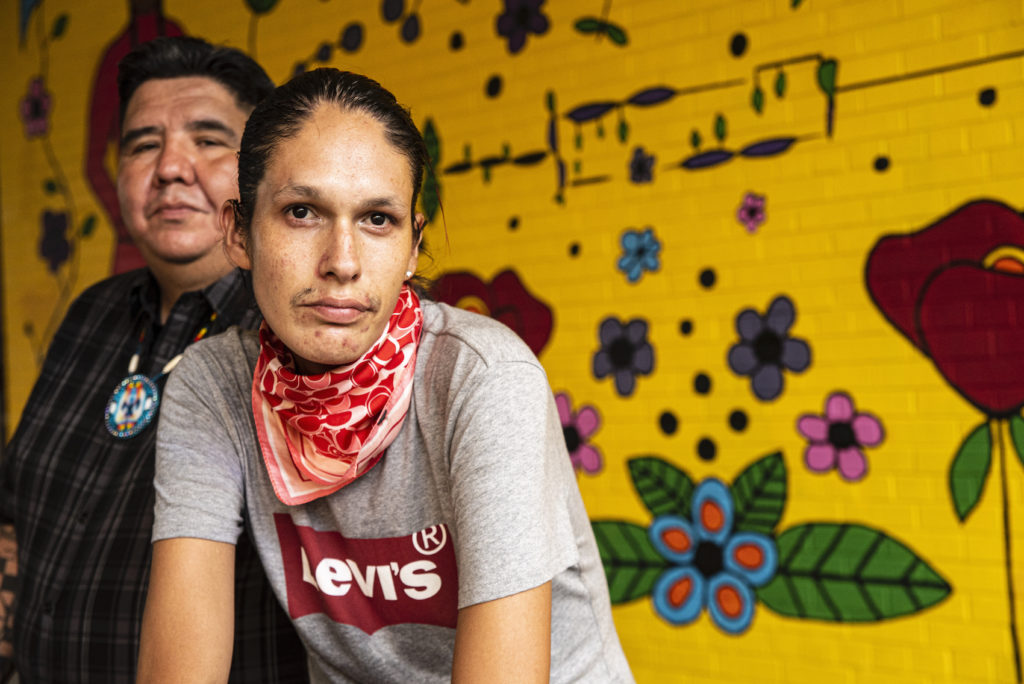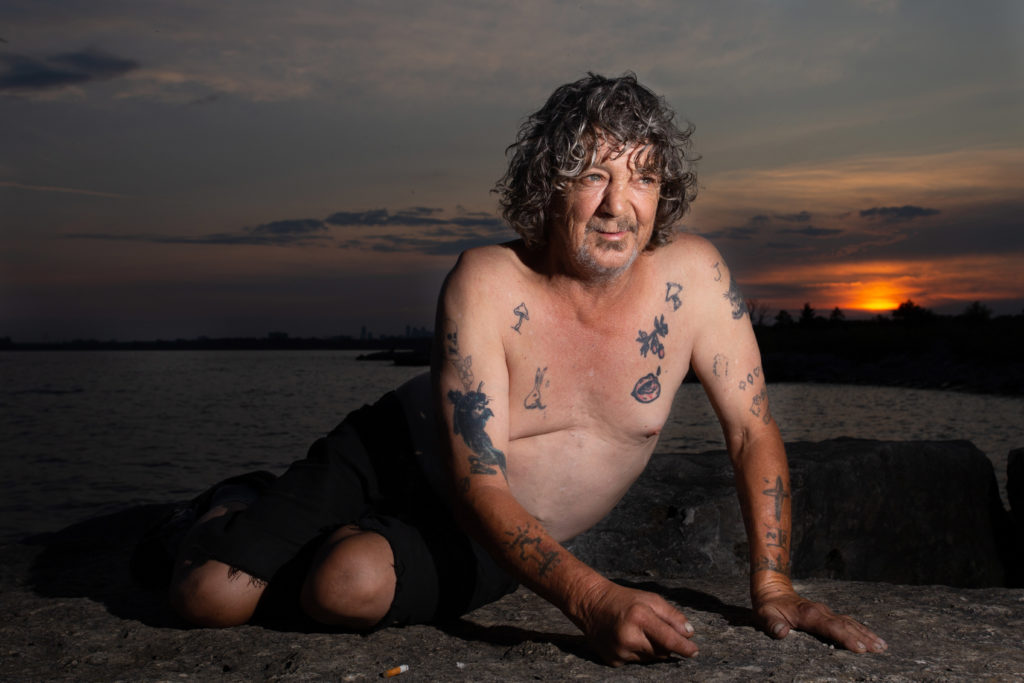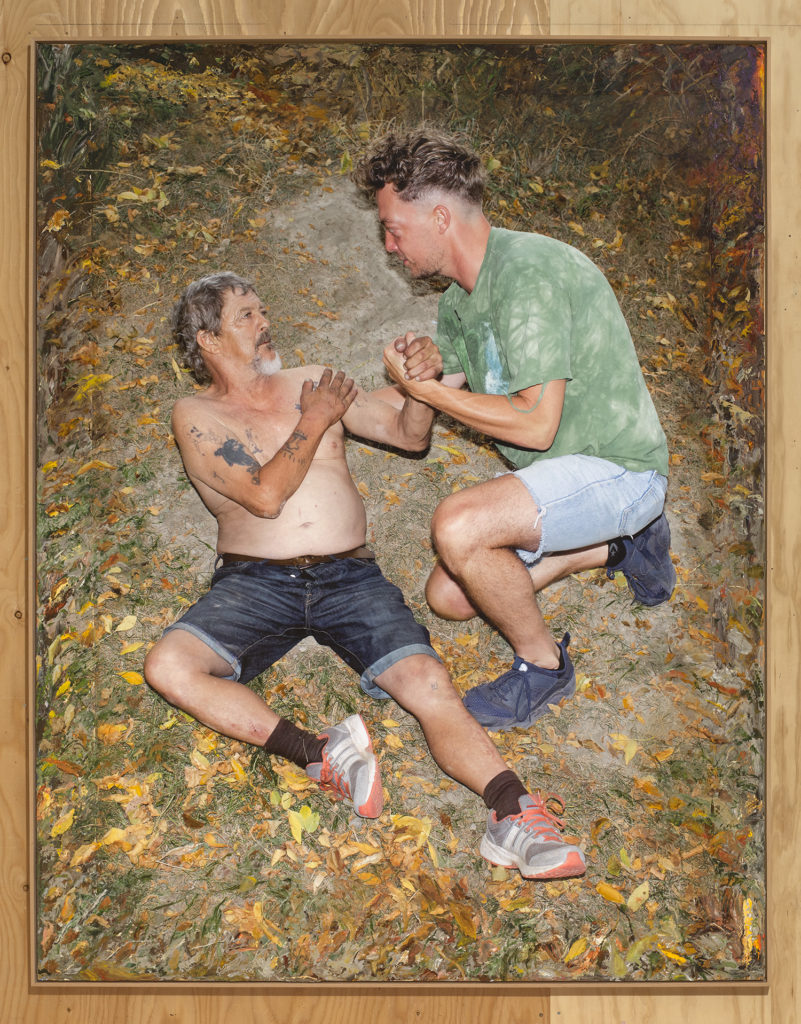Written by Declan Keogh • Photography by Declan Keogh and Jeff Bierk
A few years ago, Les William Harper did what most people have done at one time or another: he sought his mother’s opinion.
The 46-year-old Cree harm reduction worker and artist, who works at a safe-injection site in Toronto, wanted to know how she thought the overdose crisis would end and what he could do to help it along.
Elder Pauline Shirt is a survivor of Canada’s residential schools for Indigenous children. She was forced to spend years away from her family, suffering abuse under a system many, including the Truth and Reconciliation Commission of Canada, call genocide.
“That was her world she was living in,” Harper says. “She never knew if it was ever going to end.”
But it did end, eventually, and she was finally able to leave and carry on with her life. She ended up in Toronto where, in 1976, she and her then-husband Vernon Harper opened Kapapamahchakwew, or the Wandering Spirit Survival School, the first Indigenous day school in Canada.
Shirt told her son to be steadfast in his commitment to the work, and to his heritage. Canada tried to erase her culture but, she said, Indigenous teachings and practices were precisely the things that kept her alive.
“It just showed that it’s not going to stay like this. If we keep on fighting and doing what we need to do, we will find that answer,” Harper says.
Today, his mother’s advice — to honour and practice cultural traditions — grounds Harper’s work as a harm reduction worker in drug user communities, as well as in his artistic practice, painting murals. Harper works with community members to paint murals around Toronto, 10 so far. He says it’s important to bring people in to create art together, whether they’re from community centres, housing co-ops, or safe injection sites. He says it allows each individual to express themselves in a shared social context.
“I’ve always believed in art,” he says. “I want to take everyone else for the ride too.”
Crisis wears on
As Canada remains in the deadly grip of an unprecedented overdose crisis, some are turning to art to raise awareness, cope with grief and trauma, or to bring power to the community. The slow drip of solutions from health and government officials have already forced those on the front line to take things into their own hands. In Toronto, illegal safe-consumption sites started popping up in 2017, eventually forcing the provincial government to fund and sanction many across Ontario.
Despite incremental progress, people are still dying at an increasing rate. There were 4,460 opioid-related overdose deaths last year, up from 3,017 in 2016 — nearly a 33 percent increase — according to the Public Health Agency of Canada. The statistics paint a grim picture: more than 11,500 Canadians died of an apparent opioid-related overdose between January 2016 and December 2018. Fentanyl or a fentanyl analogue were involved in nearly three-quarters of the deaths.
Harm reduction workers have been saying something has to give.
The two worlds, harm reduction and art, have long overlapped. But as the crisis wears on, art is emerging as its own form of harm reduction — from an individual level to a broader political response. For Harper, the connection is personal. He’s been working in harm reduction for over a decade and has a deep connection with the community.
“There are people that I’ve grown up with that come into these sites,” Harper says. “I have relatives that come into these sites.”
‘I work in my community;
my community is me’

Wandering Spirit, which continues to operate in Toronto’s east end, is where Harper’s artistic interest blossomed. Woodland Art, originally brought to Canadian consciousness by esteemed Ojibwe artist Norval Morrisseau, remains his favourite.
Harper has adapted the Woodland style for his mural projects, an approach to painting characterized by rich, vibrant colours portraying symbolism and spirituality drawn from Anishnaabe and other Indigenous traditions.
It’s a natural fit. Woodland Style juxtaposes immemorial customs with a contemporary form; Harper, steeped in Indigenous teachings, uses them to guide his work amidst the concrete and steel of Toronto. Like his mom, he fights for life where there is death.
“My work, my passions and my personal life all connect together,” he says. “I work in my community; my community is me.”
A mural project at the Bickford Centre, in Toronto’s Koreatown, holds special significance to Harper. Two Worlds is a 20-foot-long homage to both the overdose crisis and murdered and missing Indigenous women and girls. The idea came to him during a fasting ceremony, where he prayed for guidance on how to get his message to the world.
It’s the only mural in Ontario that looks at the overdose crisis from an Indigenous perspective.
The piece depicts two faceless women in traditional pink dresses, framed by richly coloured flowers, strawberries, and a bird on a bright yellow background. In the centre is a syringe wrapped in purple. He chose purple to represent fentanyl and its role in the overdose crisis. The women represent strength and resilience.
“[Women are] why our culture is still here,” Harper says.
Harper, one of only a handful of Indigenous harm reduction workers on the front line of the overdose crisis, hopes his art will help foster dialogue between those inside and outside his community.
“People will walk by that mural and they’ll see that syringe and that Indigenous artwork and they’ll be a part of that now,” he says.
Nearly one million Canadians reported using illegal drugs in 2017, according to Statistics Canada — not including then-restricted marijuana. Yet, drug users are often imagined as a monolith. Harper hopes community art can disrupt commonly held stereotypes.
“When people first see people or think of people that are using drugs, they see them as one person,” he says. “They see them as a drug user, not as a person that’s an artist or … writer.”

Bradley Nolan, an Ojibwe service user originally from Garden River First Nation, helped Harper paint Two Worlds. Like Harper, 31-year-old Nolan has lost a lot to fentanyl: their brother, partner, and best friend.
“[Art] gets me out of the frame of mind of thinking about loved ones who have passed away from opiates,” says Nolan. They get a good feeling when they see the mural, because they know they contributed to something that stands out in the community.
“Somebody can make a piece of art and it can mean the world to them,” Nolan says. “A powerful piece of art makes people think.”
Honouring the lives of loved ones while they’re still living is an important part of Indigenous culture, Harper says, which is why the mural at the Bickford Centre is so meaningful to him.
“No matter what is happening in Indigenous culture and our lives, we’re still going on forward,” he says.
Grief and the canvas
On Jan. 7, 2019, Kira Hamilton cried throughout the night for no apparent
reason. “I didn’t have anything to cry about but I just knew something was wrong,” she says.
The next day, Hamilton, 38, went in to work at Sistering, an agency supporting at-risk women, where she does harm reduction and housing support.
I had a rough night, she thought. But I’m at work with my people. But people were staring at her, and no one said a word to her as she made her way to her office. What the hell is going on here, she asked herself.
Then she received the call. “You need to sit down,” the coworker said. “Crystal died. They found her last night. I’m so sorry.”
Crystal Papineau was found dead in a clothing donation bin. The 35-year-old’s death became front page news for months, as advocates demanded better housing and support for street-involved people — even sparking a public consultation in Toronto on the safety of donation bins.
Papineau was Hamilton’s closest client at work. “Every day … when she went off to use, or I would go home from work, she’d say ‘I love you.’” Hamilton recalls. “And, I said, ‘I love you back.’ Because she needed to hear that from somebody.”
“When you work that closely with somebody, they kind of become your family,” she says. “I cried, but I knew she wasn’t in pain anymore.”
Hamilton echoes what many in the harm reduction community describe: an impossibly complex relationship with their clients. One where the duty of care intermingles with human nature, emotion and camaraderie.
Eight more of Hamilton’s clients have died this year, many of them as a result of overdoses. When Broken Pencil reached out to Hamilton for this article, she was attending a funeral for a client. As a multi-disciplinary artist who studied fine arts at Georgian College, she feels somehow duty bound to use her paintbrush to eulogize Papineau. She envisions a darkly baroque and realistic image of a skeleton floating through the air, thick and textured like red velvet. In the skeleton’s stomach is a bright red balloon, representing “the person she was when she was alive, [and which] will keep her alive in my mind,” she says.
But when she sits down in front of her easel, Hamilton can’t bring herself to do what she had done hundreds of times: press the bristles into the paint, and gently apply it to the canvas.
Hamilton says she feels stuck, badly wanting use art to cope with the trauma of her work but, ultimately, being unable to do so. She likens it to the feeling she gets at work: spending every day trying to keep her clients alive, while faced with stagnating political action, funding cuts, and increasingly dangerous drug supplies.
Hamilton talks with a lot of her clients about art; what they’re working on, and her paintings that hang in her office. She’s planning to start an art group at work for some of her clients.
“It’s healing without realizing it, because when you’re putting the paint on the can- vas, you’re not thinking about the stuff that we have to deal with.”
Truth to power

The first time Jeff Bierk tried to get sober was after his mom died while he was in his early 20s. Shortly after, his partner at the time was in and out of the hospital.
“I felt new to the world because I was clean,” says Bierk, a Toronto-based photographer. “I had no idea who I was, I had not processed or even dealt with all the grief of both my parents dying at a young age.”
He needed a way to grieve without using drugs again. So Bierk, now 38, started to take pictures of hospital curtains between 2009 and 2010. The photos were mounted as an exhibit called Curtain at a gallery in Brantford earlier this year.
A decade after he took them, he says he’s happy to show the photos with the privilege of reflection. “I was able to re-contextualize it with all the time in between. All these ways I’ve been able to heal outside of an art practice,” Bierk says. “At the root of it was talking about my experience with death and addiction.”
Bierk is best known for his honest photos of people he knows. Many of these friends come from far-flung places but wound up in Toronto. Many struggle with housing or health; many are drug users. The images candidly depict life on the streets, a world many never experience. It’s easy for people to project assumptions onto the photos. When people see a picture of Jimmy, one of Bierk’s best friends who frequently appears in his work, they see a tough man, covered in blown-out DIY tattoos. They see salt-and-pepper hair and deep lines on his face that come with years of alcohol consumption and cold winters. It’s easy to simply read Jimmy as a drug addict or a homeless person. An undesirable.
Bierk sees beauty; he sees his friend.
“Jimmy is an example of how to be. He’s the example to me of all these beautiful things that I don’t see in a lot of other people,” Bierk says. “It’s just this freedom.”

Bierk has worked hard to get away from the traditional way photographers interact with their subjects. Jimmy is not Bierk’s subject; they are collaborators, and they split any profits. Often, Jimmy will come to an exhibit of Bierk’s work and visitors will get to meet and talk with him.
The shows “offer the potential for people to see Jimmy in the fullness of who he is … the art is a conduit for this kind of connection,” Bierk says.
In late February, Bierk took part in an open panel discussion on addiction and homelessness as part of Curtain’s run in Brantford, a city that’s been hit hard by the overdose crisis.
Between July 2017 and June 2018, Brantford and the surrounding area had one of the highest rates of overdose deaths in Ontario. Mayor Kevin Davis and other local politicians listened from the crowd as Bierk used his time on the panel to call for the city to open a safe injection site. “I remember that feeling where I was like, ‘Oh, fuck. I actually have to speak the truth to the power in this situation,’” he says.
“I spoke about my experience in a really vulnerable way,” he says, telling the crowd he was lucky and privileged — he got out of jail and was able to do a detox program where many don’t have that opportunity.
Not long after the talk, a Brantford friend messaged him with news: Brantford was going ahead with a study on opening a safe-consumption site in the city.
“It’s not that [the announcement] directly happened because of me or the art, but the art and my experience was this conduit to potentially shift the consciousness of people in the audience,” Bierk says.
Councillor Joshua Wall, whose constituency includes downtown Brantford, also attended the talk. He says the talk was one of many factors that lead the health unit to explore a safe-consumption site.
“It absolutely impacted me,” he says. “Art has the ability to inspire and elicit such strong emotions.”
“It’s unbelievably important to speak with people who have been there, who have been through turmoil and who can speak firsthand on how they’ve overcome,” Wall says. “There are so many people involved with [drug use] who haven’t been through it. There’s merit in listening to somebody who’s actually been there.”
Still, Bierk says he remains skeptical about art’s potential to foster societal change. He notes that the art world can be inaccessible. But, towards the end of our long conversation, he seems more open to the idea that the work he’s doing is creating dialogue and making people happy — even if it begins as a something for him and his friends.
‘This is the Indian that saved us’
Les Harper’s favourite colour is pink — It always has been. He says it stems from the old saying that when the evening sky is pink, the next day will be better.
He moves with an ingrained, deeply held optimism in the face of an acute crisis. Just as his mother and her generation survived, so too will he and his.
“People go through so many hardships,” he says. “Hopefully tomorrow will come and it’ll be a beautiful day.”
Harper often quotes John Trudell, a Native American activist, author and poet from Omaha, Neb., who discussed the “Drunken Indian” stereotype.
“Without them [the Drunken Indian], we wouldn’t be here today,” Trudell said in a previous interview. He said that, after centuries of forced assimilation, genocide, and oppression, there were generations that simply had to survive, by any means necessary.
“This is the Indian that saved us, because this is the Indian that said, ‘I can’t be who I am and I’m not going to be who you tell me to be, so I’ll just be nothing” he said. “I’ll be something else. I’ll just do my time and get through it. I’ll erase the pain and get through it. But I will not become you.”
Harper applies this framing to the over- dose crisis and the drug war. “We, as Indigenous people in our activism, have a great debt that we owe to the Drunken Indian because they survived,” Harper says. “We thought that one day we would be annihilated … And we weren’t.”
Harper sees parallels in the drug user community, where people remain vibrant and resilient despite terrible odds. “In this crisis that’s going on, people right now are still being the wonderful, beautiful people that they are.”
Many people in Harper’s community have died.
There is deep heartache.
But, each night, he sees pink — even in the middle of a storm.
